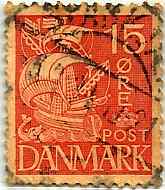 |
| 1927 Caravel Sailship Red 15 øre Typographed Denmark |
1927 Caravel Sailship Red 15 øre Typographed Denmark
Text:
15 øre Denmark Post
Condition: Ø = used/cancelled
Title:
Caravel Sailship
Face value 15 øre Denmark
Stamp Currency: øre
Country/area: Denmark
Year:
1927-01-02
Set:
1927 Sailship
Stamp number in set: 1
Basic colour: Red
Exact colour: Vermilion
Usage: Definitive
Type: Stamp
Theme: Ship, Vehicle, Sailship
Stamp subject: Caravel
NVPH number:
Michel number: 168
Yvert number: 181
Scott number: 192
Stanley Gibbons number: 246
Printing office:
Perforation: K 14 x 14½
Size: 44 x 33 mm
Watermark: Wim. 2 Multiple crosses
Paper:
Printing: Typography
Buy Now: Bid Now:
In 1927 a set of six stamps depicted a
caravel, modeled after an old engraving. The 1927 set was typographed; from
1933 to 1940 the design was reissued with the use of engraving instead. The
engraved design was soon changed to reduce the left-side margin, with the
"Type IIs" having only one column of squares between sail and frame
line, where the "Type Is" have two columns. (Both types are common
today, except for the type I 25o blue.)
During World War II, Germany occupied
Denmark, but the stamp program gives no evidence of that. A new series depicted
Christian X full-face instead of in profile, and continued in use after the
war. However mail was subject to German postal censorship.
In 1946, a new design appeared for high
values; the three lions of the state seal. Like the wavy lines design, this
design remained in regular use for the highest denominations into the 1990s.
A caravel (Portuguese: caravela, IPA: [kɐɾɐˈvɛlɐ]) is a small, highly maneuverable
sailing ship developed in the 15th century by the Portuguese to explore along
the West African coast and into the Atlantic Ocean. The lateen sails gave her
speed and the capacity for sailing to windward (beating). Caravels were much
used by the Portuguese for the oceanic exploration voyages during the 15th and
16th centuries in the age of discovery.





